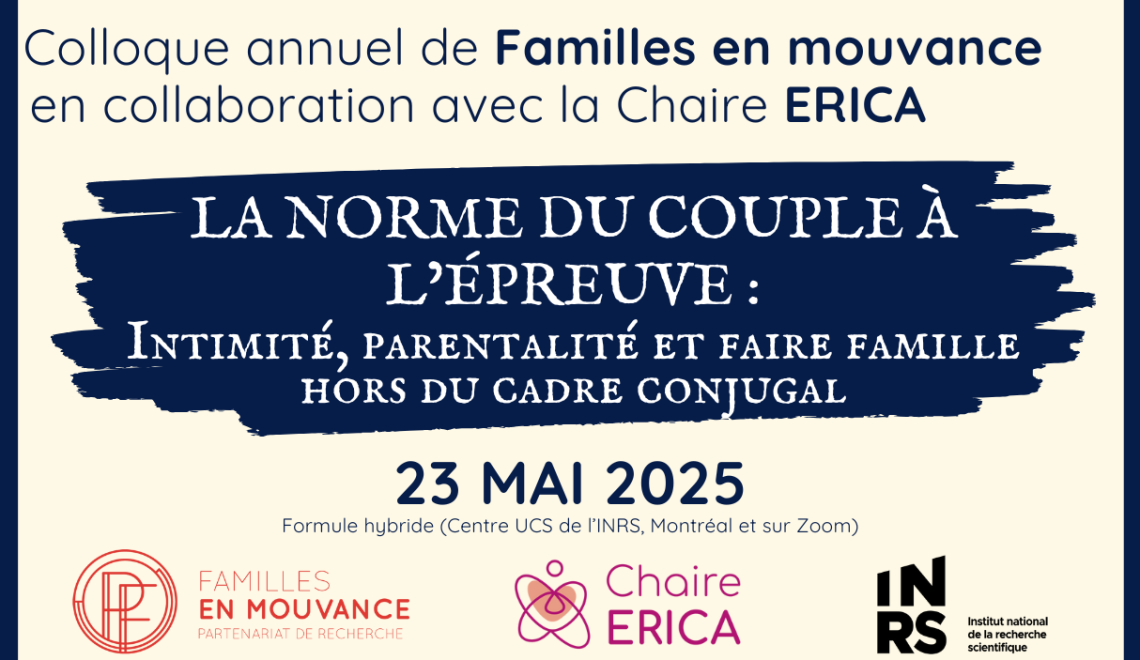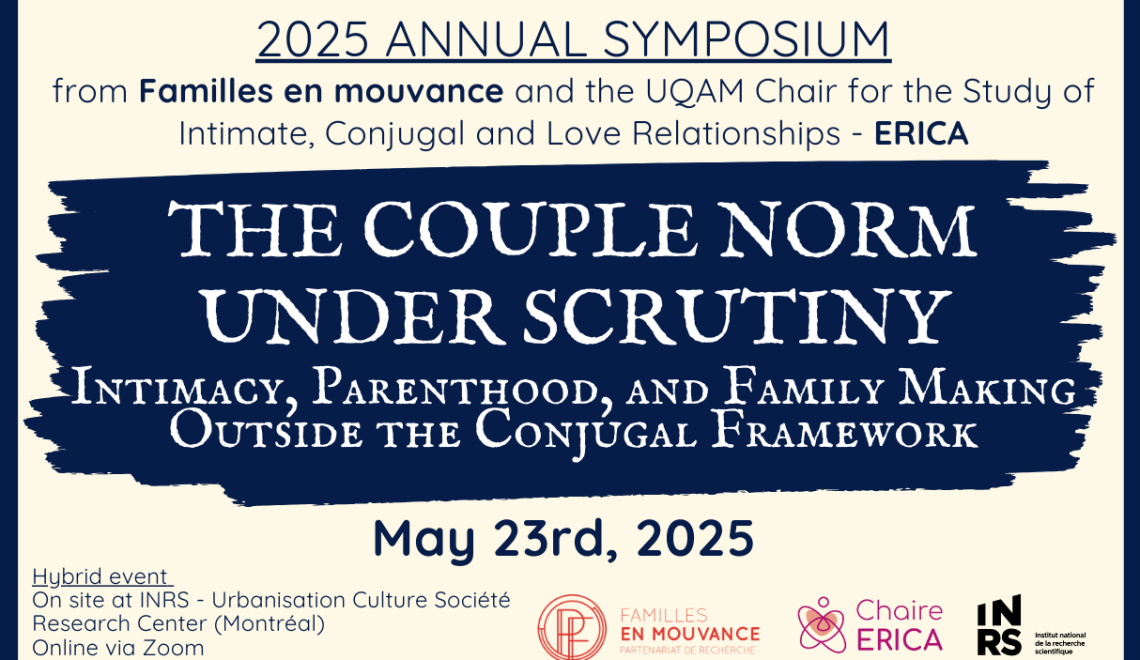
International Conference // The Social Meaning of Money: complete program
International Symposium «The Social Meaning of Money. The Work of Viviana A. Zelizer in the Area of Family Studies»
Detailed Program
Session 1: Money, Vulnerability and Gender Inequalities (9h15-11h00)
«Feminism and Separated Spheres» (Jeanne Lazarus, Sciences Po)
«The Money of the Poor in Highly Financialized Societies: From the Illusion of Control to the Creation of New Routes of Value Extraction» (Lorena Pérez-Roa, Universidad de Chile)
«Uses of Money: From the Intimate Sphere to Public Policies in the Context of Québec» (Hélène Belleau, INRS-UCS)
Discussant: Chiara Piazessi (Université du Québec à Montréal)
Jeanne Lazarus (Sciences Po)

Feminism and Separated Spheres
This presentation is based on ongoing research about the place of money issues in the various waves of feminism. In particular, it shows how the concept of separated spheres can elucidate both the ways women are dominated by money and the possibility of using money as a tool for emancipation.
First, I will trace the history of the construction of a separation between women and money, and especially between women’s bodies and money: the proximity of women and money emits a whiff of impurity, the shadow of prostitution looming, more or less explicitly. Women and money have long been perceived as separated spheres and hostile worlds.
The second part of my presentation will be dedicated to the way women’s demands for emancipation, since the 19th century, have involved money issues. Women have long decried their poverty, as their legal minority prevented them from voting and also from working and conducting economic activities in their own names. The result is dependence on men: fathers, brothers or husbands. Access to monetary ownership has long been denied to women, and they are trying to demonstrate that the paradigm of separated spheres is a source of domination and social reduction.
The third part of my presentation will look at contemporary feminism and the place it holds for monetary issues: these appear, at first glance, to be less present than they were in previous waves, replaced by questions of identity or sexuality. But this first impression is tempered by intersectional approaches that take class positions into account. Moreover, approaches that consider subjectivation or capacity development have rediscovered money matters: the ownership of oneself and one’s money are deeply related.
Lorena Pérez-Roa (Universidad de Chile)

The Money of the Poor in Highly Financialized Societies: From the Illusion of Control to the Creation of New Routes of Value Extraction
Within the multiple distinctions that Zelizer presents in her text and that help us to understand how the marking of money works, the chapter on the money of the poor acquires great relevance in my academic trajectory. Considered as a « morally dangerous currency », the author shows us how the definition of aid to the poor has been constructed on the basis of certain technical/moral definitions of who is the most suitable entity to grant aid (charity/state); who is the beneficiary likely to receive it (women/households/ »people at risk ») and what type of economic support should be given (money/species). These forms of money marking have defined the ways in which assistance is constructed, its methods of supervision/control and the limits to be established between these monies and other types of income.
The objective of this paper is to explore the moralities and disputes that have permeated the discussion on poor people’s money, through two examples of recent research: first, exploring the assumptions that financial education programs in Chile have on the financial behavior of low-income women (Pérez-Roa, Allendes and Fontecilla, 2022) and second, analyzing the controversial measure that allowed the early withdrawal of 10% of pension funds to placate the decrease of income in Chilean households due to the effects of the COVID-19 pandemic. The idea is to show how, despite the diversified forms of access to money that exist in highly financialized societies such as Chile’s, the logic of money marking maintains the moral debates that seek to control the economy of the poor, ignoring the weight of financial infrastructures in the domestic economy and reducing the financial practices of households to rational behaviors uncoupled from the economic reality of the household.
Hélène Belleau (INRS-UCS)

Uses of Money: From the Intimate Sphere to Public Policies in the Context of Québec
By overturning many received ideas, Viviana Zelizer has opened new areas of research, particularly in the field of family and private life in Québec. Drawing on her work, we developed a set of questions about intra-family dynamics (money management, saving, testamentary practices, etc.), about the very bases of certain social and tax measures and about the legal framework for spouses in Québec.
Studies conducted with Québec households reveal the variety of money management methods and their consequences – short- and long-term – on both spouses’ wallets. The «marking of money» results in the isolation of certain amounts (for me, for us), attributes a specific function to them (current expenses, savings, etc.) and sometimes clearly leads to inequalities between spouses. These findings generated new hypotheses about the legal rules governing separation. For example, our analyses have undermined the very idea of “free” and “informed” choice with regard to marriage and free union. At the root of the “common law marriage myth,” in Québec and elsewhere in the world, is the idea that the spouses, from the moment they are living together, are, by definition, a single «economic unit».
Because the economic rationale (market logic) cannot explain the economic dynamics between spouses, this analytical perspective led us to derive an opposing «love logic», with rules of conduct that influence economic behaviours within families (deferred reciprocity, altruism and disinterest, trust, etc.). These findings reveal, as does Zelizer, the extent to which money, outside the sphere of the market, is profoundly influenced by cultural and social structures.
Session 2 : The Monetary Value of Children (11h15-12h30)
«Pricing the Priceless Child 2.0: Children as Human Capital Investment» (Nina Bandelj, University of California, Irvine)
«The Value of Money in Commercial Transnational Surrogacy in India (2002 – 2015)» (Sharmila Rudrappa, University of Texas, Austin)
Discussant : Maude Pugliese (INRS-UCS)
Nina Bandelj (University of California, Irvine)

Pricing the Priceless Child 2.0: Children as Human Capital Investment
Our goal in this presentation is to take Viviana Zelizer’s (1985) Pricing the Priceless Child to the new millennium. Zelizer brilliantly documented the transformation between the 19th and 20th century from an “economically useful” to an “emotionally priceless” child. She argued that by the 1930s, American children were practically economically worthless but invested with significant emotional value. What has happened to this emotionally priceless child at the dawn of the new millennium in the United States? Has there been a new transformation in the social value of children, and, if so, what might have such transformation entailed? To address these questions, we examine overtime trends that point to increasing devotion of resources and time to children’s education, a key input in Becker’s human capital theory, which is purported to make children economically useful because of their future market value. Therefore, we argue that the priceless child 2.0 is a human capital investment child. We use four empirical examples of overtime growth, since the 1970s in the United States, in children’s human capital investment: a) enrollments in early childhood education, b) federal spending on early education, c) federal spending on K-12 programs, and d) parental spending on children’s care and education. In the conclusion, we discuss some potential consequences and concerns of raising children as human capital investment.
Sharmila Rudrappa (University of Texas, Austin)

The Value of Money in Commercial Transnational Surrogacy in India (2002 – 2015)
Value tends to be understood as a term that denotes the monetary value of something, a return of money for an equivalent in goods or services. For example, in the case I discuss in this presentation, in commercial transnational surrogacy in India (2002 to 2015), Indian working-class women provided reproductive services in gestation and childbirth in exchange for wages from intended parents. Yet, the wages for gestational services held far more meaning than being simply an exchange between the giver and the receiver of reproductive labor. Based on my field work with Indian surrogate mothers and intended parents from the US and Australia, I show the many meanings of money for the persons I met with. Though all the intended parents I interviewed expressed that the gestational labor, and the resultant babies they received were life-affirming gifts that could not be evaluated in monetary terms, some believed that the surrogate mothers should not ask for, and receive more money. For many of them, the exchange of money was straightforward: much like goods exchanged in the market, their money signified the completion of a reproductive labor contract, and the end of a market relationship. Many surrogate mothers, however, did not perceive either the exchange of money for gestational labor as a market exchange. Instead, they perceived the taking-giving as a more gift-like exchange, signifying an ongoing relationship between them and the intended parents. In this paper, building from Viviana Zelizer’s oeuvre in economic sociology, I show that more than just economic value, money traces social value. The money exchanged in surrogacy embodies the meanings of myriad relationships that emerge from the time of conception to the point of childbirth between intended parents, their surrogated children, the doctors, proprietors of surrogacy agencies. Money is never just money. Instead, money maps the social values embedded in social relationships.
Session 3 : Embedded Money: Identity and Morality (14h00-15h45)
«Financial Resources of Inuit Women Benefiting Land-Based Activities» (Magalie Quintal-Marineau, INRS-UCS)
«Money without Morality shapes Economic Abuse across Cultures» (Supriya Singh, RMIT University)
«The Sociology of Money and Household as Social and Moral Order: Viviana Zelizer’s Work as Inspiration» (Ariel Wilkis, Univsersidad Nacional de San Martin)
Discussant : Jean-François Bissonnette (Université de Montréal)
Magalie Quintal-Marineau (INRS-UCS)

Financial Resources of Inuit Women Benefiting Land-Based Activities
In the Canadian arctic, economic matters are dominated by a discourse that advocates embracing the globalized economy through the development of extraction megaprojects. The weight of this discourse has historically effaced erased the distinctive economic practices of Inuit. Recent studies on the role of Inuit women in the region’s economy and within families have shed light on social and cultural practices that differ significantly from economic rationality and the market logic.
Drawing on Zelizer’s work on the social meaning of money, this presentation explores the integration of Inuit women into the labour market and the way they use their economic resources. Since the turn of the 21st century, women have made fast inroads into the job market, with employment rates exceeding those of men and similar or higher annual incomes, by age bracket. Today, not only have women become the main breadwinners in many households, but their financial contribution has also become necessary for maintaining land-based activities (defined as hunting, fishing and gathering). Women’s money circulates within their families but also more widely in the community, in the form of gifts, allowances and through the purchase of equipment for subsistence activities.
Through a variety of intra- and inter-family income transfer and redistribution mechanisms, women help maintain the connection to the land and consolidate Inuit identity and cultural practices. Recent studies conducted in Nunavut demonstrate that the money intended for land-based activities is “marked” and takes on a distinctive social and cultural value that eludes economic rationalities. These findings echo Zelizer’s work, which posits that economic relationships and the use of money are socially and culturally constructed.
Supriya Singh (RMIT University)

Money without Morality shapes Economic Abuse across Cultures
Money as a medium of care becomes a medium of abuse when it is used without its accompanying morality. The devastation of coercive control is the same across cultures. However, cultural practices such as the joint account and remittances, symbols of care and intimacy, become abusive when they deny and appropriate money to subjugate agency and human rights.
Ariel Wilkis (Universidad Nacional de San Martin)

The Sociology of Money and Household as Social and Moral Order: Viviana Zelizer’s Work as Inspiration
In this paper I would like to share reflections about the relationship that my work has had with Viviana Zelizer’s sociology, focusing on three different moments that are linked to expand the sociological interpretation of the households’s uses and meanings of money and indicate the broader shifts in terms of knowledge that this expansion has allowed. In order to carry out this reconstruction, I would like to first situate the place of Zelizer’s work in the panorama of Argentine social sciences in order to contextualize the innovations that it has enabled in different works such as my own. Subsequently, I will focus on three investigations carried out during the last 15 years that have been strongly inspired by Zelizer’s work. First, the economic ethnography of the popular world of Buenos Aires (Wilkis, 2017), where I show in detail how monetary practices help to produce a moral and social order, second, the socio-historical research on the place of the US dollar in Argentine society (Luzzi and Wilkis, 2023) and, finally, a currently research on household indebtedness dynamics in the context of the Covid19 pandemic. In each of these stages I will illuminate how Zelizer sociology has allowed us to expand our knowledge of the relationship between households and money in specific social and historical contexts of Argentine society, opening lines of interpretation that were absent in the context of academic and public debate. I will close my intervention with a reflection on the role of Zelizerian sociology as public sociology (Buroway, 2005).
Viviana A. Zelizer (Guest of honor) : Closing remarks (15h45)








